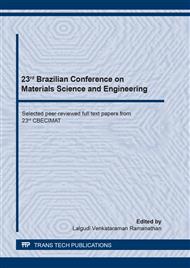p.3
p.9
p.14
p.20
p.26
p.32
p.37
p.43
Elastic Wave Propagation in a Bio-Inspired Phononic Crystal
Abstract:
The wave propagation in a two-dimensional bio-inspired phononic crystal (PC) is analysed. When composite materials and structures consist of two or more different materials periodically, there will be stop band characteristic, in which there are no mechanical propagating waves. These periodic structures are known as PCs. PCs have shown an excellent potential in many disciplines of science and technology in the last decade. They have generated lots of interests due to their ability to manipulate mechanical waves like sound waves and thermal properties which are not available in nature. The physical properties of PCs are not essentially determined by chemical elements and bonds in the materials, but rather on the internal specific structures. Structures of this type have the ability to inhibit the propagation of vibrational energy over certain ranges of frequencies forming band gaps. The main purpose of this study is to investigate the band structure and especially the location and width of band gaps. For this analysis, it is used the finite element method (FEM) and plane wave expansion (PWE). The results are shown in the form of band structure and wave modes. Band structures calculated by FEM and PWE present good agreement. We suggest that the bio-inspired PC considered should be feasible for elastic vibration control.
Info:
Periodical:
Pages:
9-13
Citation:
Online since:
October 2020
Price:
Сopyright:
© 2020 Trans Tech Publications Ltd. All Rights Reserved
Share:
Citation:


